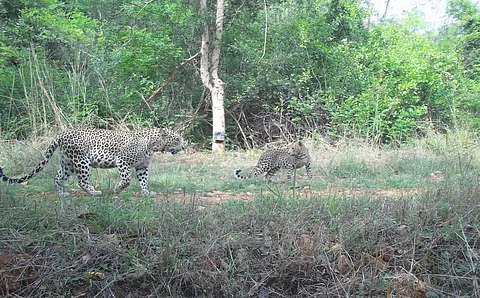

Bengaluru and its immediate surroundings may have surpassed Mumbai as being the Indian metropolitan city with the largest leopard population. A year-long camera-trap survey found 80-85 animals in the forests and scrublands fringing the southern metropolis.
The survey was conducted by Holématthi Nature Foundation (HNF), led by conservation biologist and leopard expert Sanjay Gubbi, according to a statement.
It found that 54 of the 80-85 individuals are inside the Bannerghatta National Park (BNP). “The remaining ~30 leopards roam reserved, deemed and private forests scattered across the metropolitan periphery,” according to the statement.
The team deployed more than 250 camera traps across 282 square kilometres of mixed habitat—Turahalli, Turahalli Gudda, B.M. Kaval, U.M. Kaval, Roerich Estate, Gollahalli Gudda, Sulikere, Hesaraghatta, Marasandra, Manduru and adjoining government and private lands—as well as throughout BNP.
Mumbai has a documented population of ~54 leopards. Bengaluru’s figures mean that it is now the large metropolis with the highest known number of free-ranging big cats.
The statement highlighted that the number of leopards in BNP had steadily arisen—from 40 in 2019, 47 in 2020 to 54 in 2025. “HNF attributes the increase primarily to stricter protection that has improved prey availability, though the past translocation of conflict leopards from other districts may also have contributed,” the statement added.
“It (Bengaluru) is also the only metro whose fringes still support an ensemble of tigers, leopards, dholes, elephants, gaur, sambar and other large mammals. The credit is also to the people co-existing with leopards and other large wildlife.
HNF’s own survey photo-captured 34 mammal species besides leopards, four of them Endangered and four Near Threatened on the IUCN Red List.
“22 species fall under Schedule I and five under Schedule II of India’s Wildlife (Protection) Act 1972—underscoring the national and global importance of safeguarding Bengaluru’s remaining natural habitat,” as per the statement.
The survey was carried out by Gubbi, Shravan Suthar, Sandesh Appu Naik, Poornesha H C, Mayur Mirashi, Aishwarya Karanth and field assistants from local communities.
Among key recommendations suggested by HNF are intensifying community outreach so Bengaluru’s rapidly expanding suburbs can coexist safely with leopards. “Halt further translocation of leopards into BNP; instead, address root causes of human–leopard conflict at the source sites,” it added.